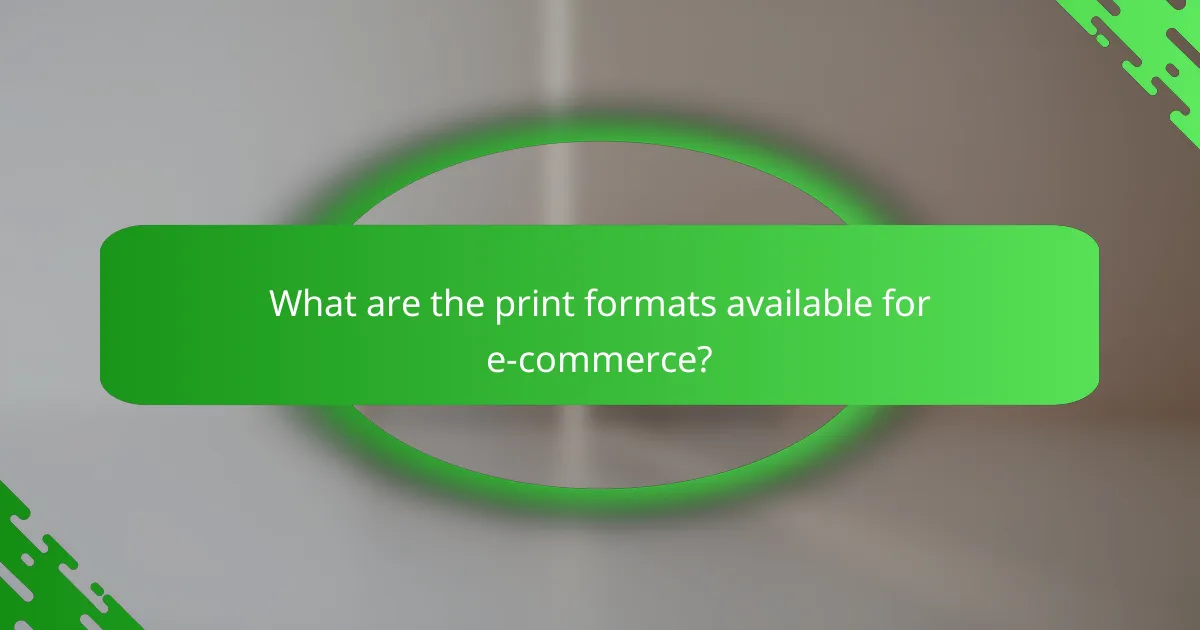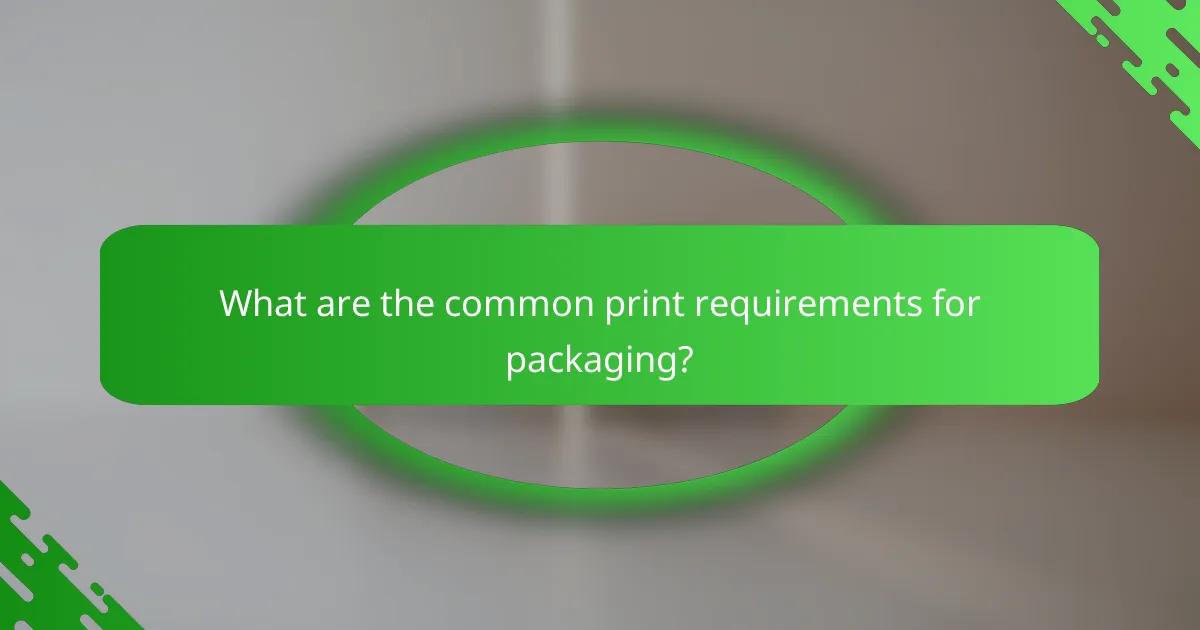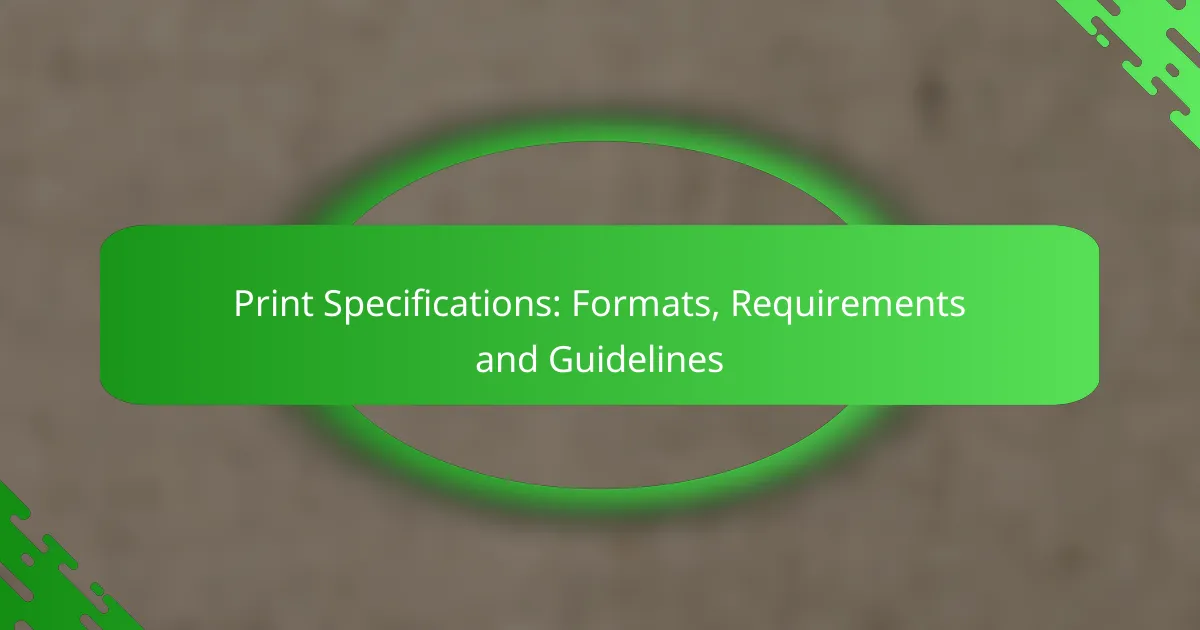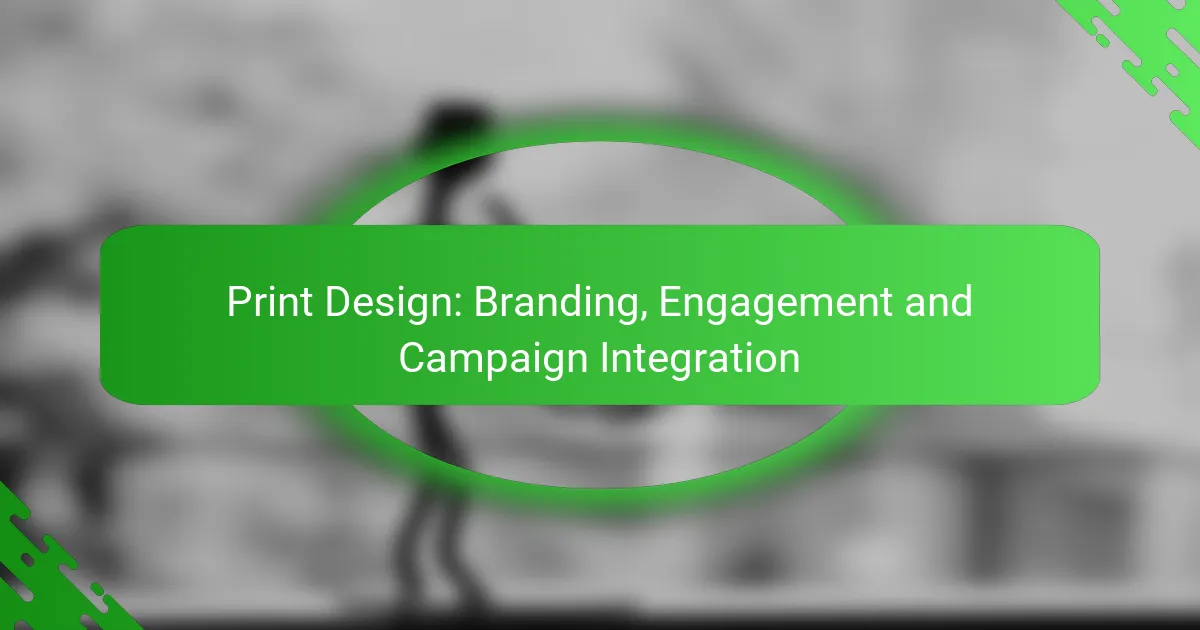In the world of e-commerce, selecting the right print specifications is crucial for ensuring high-quality materials that effectively represent your brand. Various print formats cater to different applications, and understanding key requirements such as resolution, color modes, and file formats can significantly impact the final product. By evaluating your specific needs and budget, you can make informed choices that enhance your printing outcomes.

What are the print formats available for e-commerce?
Several print formats are available for e-commerce, each suited for different applications and products. Understanding these formats can help businesses choose the right method for their printing needs, ensuring quality and efficiency.
Digital printing
Digital printing involves transferring digital images directly onto various media. This method is ideal for short runs and offers quick turnaround times, making it suitable for personalized products or small batch orders.
Common uses include business cards, brochures, and labels. It typically has lower setup costs compared to other methods, but the cost per unit can be higher for larger quantities.
Offset printing
Offset printing uses plates to transfer ink onto a substrate, allowing for high-quality prints in large volumes. This method is cost-effective for bulk orders, as the price per unit decreases with higher quantities.
It is commonly used for magazines, newspapers, and packaging. However, the initial setup costs can be significant, making it less ideal for smaller runs.
Flexographic printing
Flexographic printing employs flexible relief plates to print on various materials, including plastic, paper, and cardboard. This method is particularly effective for packaging and labels, offering high-speed production and vibrant colors.
Flexography is often used for food packaging, as it can print on non-porous substrates. The setup costs can be high, but it becomes economical for large production runs.
Screen printing
Screen printing involves pushing ink through a mesh screen onto the substrate, making it suitable for textiles, promotional items, and signage. This method is known for its durability and vibrant colors.
While it is cost-effective for larger quantities, the setup time can be lengthy, making it less practical for small orders. It is often used for custom apparel and merchandise.
Letterpress printing
Letterpress printing is a traditional method that uses raised surfaces to create impressions on paper. This technique is valued for its tactile quality and is often used for high-end stationery and invitations.
While it offers a unique aesthetic, the process can be labor-intensive and is generally more expensive than modern printing methods. It is best suited for small runs where quality and detail are prioritized.

What are the key print specifications for e-commerce products?
The key print specifications for e-commerce products include resolution requirements, color modes, file formats, and bleed and trim sizes. Understanding these specifications ensures that printed materials meet quality standards and effectively represent the brand.
Resolution requirements
Resolution is crucial for print quality, typically measured in dots per inch (DPI). For most e-commerce products, a resolution of at least 300 DPI is recommended to ensure sharp and clear images.
When preparing images, avoid using lower resolutions, as they can result in pixelation and a poor final product. Always check the resolution of your images before submission to ensure they meet this standard.
Color modes
Color modes determine how colors are represented in print. The two primary modes are RGB (Red, Green, Blue) and CMYK (Cyan, Magenta, Yellow, Black). For print, CMYK is the standard as it aligns with the color mixing process used in printing.
When designing for print, convert RGB images to CMYK to avoid unexpected color shifts. This conversion helps maintain color fidelity in the final printed product.
File formats
Common file formats for print include PDF, TIFF, and EPS. These formats preserve image quality and are widely accepted by printing services. PDFs are particularly popular due to their versatility and ease of use.
Avoid using formats like JPEG for final print submissions, as they can compress images and reduce quality. Always check with your printer for their preferred file formats before submission.
Bleed and trim sizes
Bleed refers to the area outside the final trim size that ensures color extends to the edge of the printed piece. A standard bleed size is typically 1/8 inch (0.125 inches) on each side.
Trim sizes are the final dimensions of the printed product. Make sure to account for bleed in your design to avoid white edges. Always verify the required trim sizes with your printing service to ensure compliance.

How to choose the right print specifications for your project?
Selecting the appropriate print specifications for your project involves understanding your specific needs, desired quality, and budget constraints. By carefully assessing these factors, you can make informed decisions that align with your project’s goals.
Assessing project needs
Begin by defining the purpose of your print project. Consider the type of materials you need, such as brochures, business cards, or posters, and the intended audience. This will help determine the format, size, and quantity required.
Next, think about the distribution method. Will the prints be mailed, handed out at events, or displayed in stores? This influences choices like paper weight and finish, which can enhance durability and presentation.
Evaluating print quality
Print quality is crucial for making a strong impression. Assess the resolution needed for your images and graphics; typically, 300 DPI is standard for high-quality prints. Ensure that your files are prepared correctly to avoid pixelation or blurriness.
Additionally, consider the color mode. For print, CMYK is preferred, as it provides a more accurate representation of colors on paper compared to RGB. Conducting a test print can also help evaluate how colors and details translate from screen to print.
Cost considerations
Budgeting for print projects requires a clear understanding of costs associated with materials, printing methods, and finishing options. Prices can vary significantly based on paper quality, ink types, and production techniques.
To manage costs effectively, obtain quotes from multiple printing services and compare them. Look for bulk discounts if you need large quantities, and consider digital printing for smaller runs, as it can be more cost-effective.

What are the common print requirements for packaging?
Common print requirements for packaging include material selection, size and dimensions, and labeling guidelines. These factors ensure that the packaging is functional, compliant with regulations, and visually appealing to consumers.
Material selection
Choosing the right material is crucial for packaging as it affects durability, cost, and environmental impact. Common materials include cardboard, plastic, and glass, each offering different benefits such as weight, strength, and recyclability.
Consider the product type and its storage conditions when selecting materials. For instance, food packaging often requires materials that are moisture-resistant and safe for direct contact with consumables.
Size and dimensions
Accurate size and dimensions are essential for packaging to ensure products fit securely and are easy to handle. Measure the product carefully and allow for additional space if necessary, especially for protective padding.
Standard sizes can help reduce production costs and streamline logistics. However, custom dimensions may be required for unique products, which can increase expenses and lead times.
Labeling guidelines
Labeling guidelines dictate the information that must be included on packaging, such as product name, ingredients, and barcodes. Compliance with local regulations is critical, as different countries have varying requirements for labeling.
Ensure that labels are clear and legible, using appropriate font sizes and colors that contrast with the background. Consider including symbols for recycling or safety information to enhance consumer understanding.



